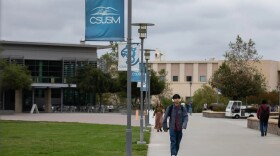Robots are at work full time in a UC San Diego lab, creating challenging conditions for different cellular compounds. The robot arms remove the cells from one liquid solution and expose them to an even more harsh environment to see if they can survive it.
This happens around the clock so they can evolve and become the best organism for a certain task.
"Basically, what we can do is create an environment where we can grow them reproductively over and over again, and the ones that are fittest and grow the fastest, will win out and have a selection for the property that we want,” said Adam Feist, a research scientist in the bioengineering department at UCSD.
Living things evolve to fit their environment. At UC San Diego they’re accelerating the process to create organisms that do some important jobs for us.
What tasks will these compounds be selected to do? Maybe they will consume plastic waste. They can create chemical building blocks to transform organic waste into medicines or into building materials like plastic.
Again the process used in this bioengineering factory is evolution. Scientists are just giving it a push.
“So, what we’re actually doing is we’re using the natural process of evolution and we’re enabling it on a faster scale. So the microbes themselves are growing and dividing and mutating. Just like they do in the wild, and they’ve done for billions of years,” Feist said.
“We’re just facilitating that process here in the lab and selecting them under specific conditions, to get the ones that are useful for our application.”

Case in point.
The Feist lab created a bacterial spore that was conditioned to withstand the high heat of plastic manufacturing, and would consume polyurethane. It could be added to the production of polyurethane so, when it was discarded or composted, the spores would wake up and devour the plastic.
I wondered whether the creation of new micro organisms could backfire and wreak havoc, if released into the environment. Kind of a Frankenstein’s monster microbe.
Feist said their creations were unlikely to be a bully in the real world, as they’ve been crafted to do a specific thing.
“A lot of the times when you evolve them and engineer them heavily to do it, they get out-competed when they’re in nature and only work in these specific environments,” he said.
The vision of bioengineering is that biological processes are more efficient and effective than anything we can create with electronics or mechanics. Feist said the raw materials of bioengineering are all around us. Even the plants in our green waste bins.





